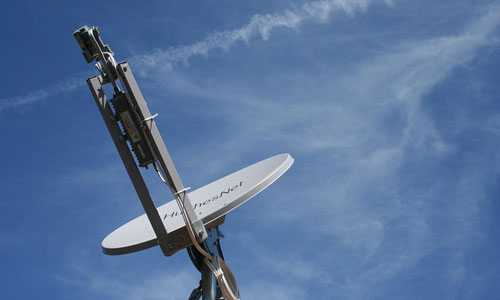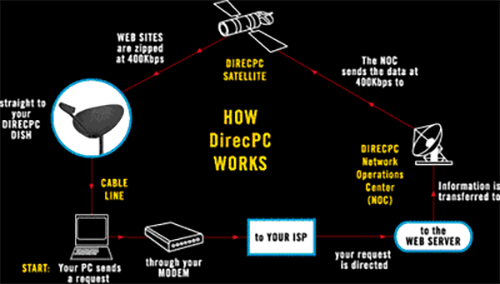We Were Promised Skynet
Satellite internet was once seen as a holy grail of connect-anywhere online access. It hasn’t worked yet, but the promise is closer than ever.
Hey all, Ernie here with a refreshed piece on satellite internet access, a concept that has sucked for years, but may soon suck far less. Here’s a refresh to explain its history and the changing landscape.
Why is Cats a musical? Didn't anyone think it was a weird idea? In each episode of the podcast Sunday in the Heights with Dolly! we take a deep dive into the stories behind Broadway's biggest shows. Learn how Evita beat bad reviews, how Annie beat socialists and then became one, and how the cast of Hair became a true close-knit tribe (spoiler: constant sex).
“A body in such an orbit, if its plane coincided with that of the earth’s equator, would revolve with the earth and would thus be stationary above the same spot on the planet. It would remain fixed in the sky of a whole hemisphere and unlike all other heavenly bodies would neither rise nor set.”
— Science fiction author Arthur C. Clarke, writing in Wireless World magazine back in 1945 about the idea of stationary satellites that could be held in place around the Earth’s orbit, allowing them to be used to service communications around the world. Clarke’s essay proved incredibly influential on the satellite industry. Just 20 years after his essay was published, the satellite Intelsat I went up into orbit, effectively following his geostationary strategy. The satellite was put into orbit by the Hughes Aircraft company.
A video simulation of the Teledesic constellation of satellites that would have given us fast worldwide satellite internet.
We haven’t actually seen the dream of satellite internet as it was originally intended
The internet wasn’t initially globally accessible, though it eventually worked its way up to that.
But some saw the global potential early—particularly in the world of satellites. For example, the company Teledesic wanted to create a whole network of hundreds of satellites that would provide high-speed internet access around the world. The company had a big name backer—a guy named Bill Gates—and ambitious plans.
At one point, Teledesic pitched the idea of building a $9 billion satellite system, complete with the support of Boeing. This system, which would have involved hundreds of individual satellites circling the globe, was built around a broad vision of turning satellite internet into a mainstream product.
(And it wasn’t alone: Motorola, at one point, backed the satellite firm Iridium Communications, which planned a $5 billion network of its own.)
Daniel Kohn, who helped operate the company, put forth an impressive vision of what the Teledesic network, once completed, would look like. In an essay for the Internet Society, he described a low-Earth-orbit satellite network, based on the Ka satellite band, that would provide internet speeds as fast as fiber-optic cables, no matter where you were globally.
“The promise of the information age is constrained by the lack of access to switched, broadband services in most of the developed and virtually all of the developing world,” Kohn explained in the essay. “The Teledesic Network will provide a means to help extend these switched, broadband connections on demand anywhere on Earth.”
There was a problem, however, and the passage of time highlighted how big a problem it was. In his essay, Kohn made a prediction about fiber-optic-driven internet access that turned out to be incredibly wrong:
While there is a lot of fiber out there in the world—and the number of places is growing—it is used primarily to connect countries and telephone company central offices. Even in a country like the United States, little of that fiber will be extended for local access to individual offices and homes, which represents 80 percent of the cost of a network. In most of the world, fiber deployment likely never will happen.
As any FIOS or Google Fiber subscriber will tell you, we do in fact have fiber optic cable that goes to many homes—not all, but far more than Kohn’s general prediction implied. The value of the internet was such that companies were actually willing to spend massive amounts of capital on those last-mile fiber-optic connections. Additionally, the success of coaxial cables in providing fast internet access to users around the world helped muffle some of the need for a massive satellite internet network.
That said, Kohn’s point remains valid. There are still lots of parts of the world that don’t have fast internet access. It just turned out that there were far fewer than the audacious plan anticipated.
And as a result, the market for satellite internet is immensely disappointing in comparison to Teledesic’s aspirations. It’s no wonder that the company eventually faded away. Despite talking a big game and having big-money backers, the company eventually stopped building its audacious idea in 2002, with little to show for it despite hundreds of millions of dollars in investments.
“We think there’s still demand in the market for these services,” Teledesic spokesman Todd Wolfenbarger told the Seattle Times at the time. “But absent of some other partner, it’s not going to happen.”
We did get satellite internet, but it didn’t look anything like the big idea Teledesic was trying to sell.
$25M
The amount that former Pan Am executive Dan Colussy, along with a group of fellow investors, purchased the bankrupt Iridium satellite network for in 2000, in what might rank as one of the best business deals of all time. The company bought a network of 77 satellites for 0.5 percent of the price it cost to build the network. (Cloussy sold the network for $591 million in 2008, making his investment back 24 times over. Again, smart deal.) The company, whose network was also based on low-Earth-orbit satellites like Teledesic, focused less on mainstream audiences and more on niche needs, such as the U.S. military. As Via Satellite notes, Intelsat is in the midst of a refinancing at the moment so it has seen recent losses, but still makes more than $100 million in revenue quarterly, and the firm only passed a million subscribers in 2018.

A HughesNet satellite dish. (Alan Levine/Flickr)
For years, the satellite internet we actually got was lame and frustrating
Ever see the movie The Aviator, about reclusive pilot and billionaire Howard Hughes?
Yes, the Hughes in HughesNet, the internet service, refers to Howard Hughes. No, he doesn’t really have a connection to the whole satellite-based internet firm—other than the fact that it’s a distant descendant of his aviation business.
Now owned by EchoStar, HughesNet carries its current name because it was at one point owned by the Hughes Aircraft Company, but the firm wasn’t acquired until about a decade after Howard Hughes had died. But the reclusive tycoon’s firm did have a legacy in satellites before that point.

A graphic explaining how DirecPC initially worked. (via SatelliteDish.com)
And that legacy, starting in 1996, was used to bring internet to homes. That year, Hughes—which owned DirecTV at the time—launched its DirecPC service, one of the earliest broadband services available in homes nationally. It was an awkward approach, letting users download via a speedy-at-the-time Hughes Network Systems Galaxy IV satellite, but managing the upload part of the equation through modems on the ground. (Considering the somewhat convoluted process, it’s understandable why it didn’t take off.)
The service slowly evolved from there, becoming DIRECWAY back in 2001, and eventually HughesNet in 2006 after DirecTV and Hughes were separated from one another.
Then and now, HughesNet follows the Arthur C. Clarke ideal—a single satellite that effectively stays in place 22,000 miles above the earth. This kind of distance is fine if you’re beaming television into your living room or loading a webpage, but if you’re trying to play a game, it’s not so hot. As a result of this distance factor, a whole lot of money has to be spent to modestly improve the quality of the internet connection you get via a satellite.
Fortunately, competition also helps: In 2011, the ViaSat-1 satellite got up in the air in 2011, allowing for the competing Exede internet service, later renamed ViaSat, to help slowly nudge HughesNet into the future.
Since then, EchoStar and ViaSat have been going back and forth upgrading their satellites to offer better connections to rural satellite users.
A few years ago, HughesNet announced a speedier internet service after launching a new satellite. But despite the massive investment, it’s only speedier compared to the previous version of HughesNet.
The upgrade only gets the network to 25 megabits per second, which pales in comparison to home internet offerings. For comparison’s sake: When cable internet technology first came on the scene in 1995, the technology was capable of transmitting data at 27 megabits per second.
Despite its technology being upgraded at a regular clip for two decades, satellite internet has only just now crept up to where cable internet was a quarter-century ago. Think about that.
A promotional clip for NightShift, a former time-shifting service for satellite internet platforms.
The various quirks that come with modern-day satellite internet access
- Limited bandwidth. Ever been on an airplane WiFi connection, or perhaps on a train? Now imagine sharing a slightly faster version of that connection with the entire country. That’s pretty much what you’re doing when you use satellite internet—literally, in the case of an airplane.
- Slow upload speeds. Always the achilles heel of satellite internet, uplink speeds have always been a small fraction of downlink speeds. The reason for this is that users are effectively sharing the ability to upload with a single satellite, meaning your data gets sent in bursts—and have to wait your turn. In industry parlance, this is called Time Division Multiple Access, or TDMA—a technology that was once commonly used with cellular networks.
- High latency. When your connection has to communicate with a satellite 22,000 miles in the air, there are going to be delays. HughesNet ecommends against playing real-time games using its network, because of latency problems. “With satellite service, the data must travel up to the satellite and back (about 22,000 miles),” the company writes in an FAQ. “This round trip adds about a half-second delay to the total time your computer takes to communicate with a Website or host server. That will prevent real-time, multi-player games from establishing or maintaining a reliable connection with the gaming server.” So no Quake for you.
- Data caps. You think data caps are bad on your mobile phone? You’ve never dealt with satellite connections, which face artificial speed limitations because there are only so many satellites in space. As a result, satellite connections are way more expensive than other types of home internet access.
- Overage problems. Back in the 1980s and 1990s, many early dial-up users would shift their schedules basically to get cheaper, less congested online access. This kind of thing hasn’t been a problem for years on most mainstream internet connections, but remains one for services like HughesNet or Exede, which loosen their caps on bandwidth in the middle of the night. At one point, this created the need for a service called NightShift, which got around the problem by time-shifting Netflix content, TiVo style. (The service was shut down in 2017, however.)
“Now, let’s talk about what made me want to beat this thing to death with a chair.”
— MacWorld reviewer Séamus Bellamy, discussing his experience reviewing the Iridium Go portable satellite internet device, a $799 device that offers online connectivity through Iridium’s satellite network, which is generally used for satellite phones and business communication needs. The problem is, the network is really slow for internetting—about the same speed as a 2400-baud modem—and as a result, the device has limited capabilities. It can only surf the web through a dedicated app, offered low-quality calling, and was only really good for texting when it came down to it. Faster portable satellite options exist, but they cost even more.
HughesNet and ViaSat, while far lot better than nothing at all, don’t properly represent what Teledesic was pitching two decades ago. They’re single satellites, built on the Arthur C. Clarke model and located tens of thousands of miles above the Earth, rather than mesh-like model of hundreds of satellites that Teledesic was pitching.
The failings of this model can be seen in the slow upload speeds. If there were more satellites and if they were closer to the Earth, the technology would simply work better.
(Iridium’s network, based on low-Earth orbit satellites, is about halfway there, but is in dire need of a technological upgrade and serves a more niche audience at this juncture.)
Fortunately for everyone, companies are starting to give Teledesic’s audacious idea another shot.
SpaceX’s Starlink, which has a receiver described as a “UFO-on-a-stick,” has been generating tons of excitement this week, as it looks like the first version of satellite internet access that people will prefer to use compared to traditional wired options. Starlink, which Musk has been big-upping on Twitter this week when he hasn’t been big-upping bitcoin, will rely on a network of low-orbit satellites that will avoid the latency problems that HughesNet has famously had, and offer speeds up to 1 gigabit per second—faster than many wired options at this time.
And Musk isn’t alone on this. OneWeb, also promised the launch of commercial services this year after putting a manufacturing facility in production last year. But its picture has been cloudier than what SpaceX has seen. Soon after the company had launched more than a dozen satellites into orbit in mid-March, OneWeb filed for bankruptcy, and is in the midst of getting bailed out by (not kidding) the British government in one of their boldest post-Brexit moves. The move by a global superpower to purchase a satellite internet provider means that Elon Musk is now competing against a major government that likely has deeper coffers than he does.
The dynamic of all this stuff is really interesting if you think about it. Over the years, some of the world’s biggest icons of business and technical visionaries have been focused on this problem in some way big or small. From Arthur C. Clarke to (indirectly) Howard Hughes to (very much directly) Elon Musk, these associations show just how futuristic this could actually be. But the truth is that it’s been disappointing so far. If Musk pulls off his big plan, though, satellite might turn into the most innovative form of internet access overnight.
This stuff is all new technology, but it’s based on an old idea—an idea that might finally see its moment in orbit.
--
Find this one an interesting read? Share it with a pal! And thanks again to our sponsor Sunday in the Heights with Dolly!
:format(jpeg)/2017/03/tedium033017.gif)
/2017/03/tedium033017.gif)


/uploads/ernie_crop.jpg)